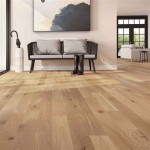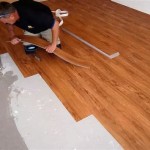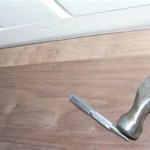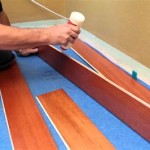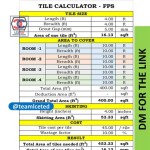Bleached Wooden Flooring: Aesthetics, Durability, and Maintenance
Bleached wooden flooring, a distinctive and increasingly popular stylistic choice, offers a unique aesthetic that sets it apart from traditionally stained or finished wood floors. This type of flooring undergoes a process to lighten the natural color of the wood, resulting in a pale, often whitewashed appearance. The resulting look can range from a subtle, sun-kissed effect to a dramatic, almost Scandinavian-inspired starkness, significantly impacting the ambiance of a room.
The process of bleaching wood is not merely a surface treatment; it involves chemical reactions that alter the pigments within the wood fibers themselves. This distinguishes it from simply applying a light-colored stain or paint, which primarily sits on the surface. The result is a more natural and enduring color change that allows the wood grain to remain visible, preserving the inherent character of the material.
The appeal of bleached wooden flooring lies in its versatility. It complements a wide range of interior design styles, from minimalist and modern to coastal and rustic. It creates a sense of spaciousness and light, making it an excellent choice for smaller rooms or spaces with limited natural light. Furthermore, the neutral color palette of bleached wood provides a flexible backdrop for various furniture styles and color schemes.
Understanding the Bleaching Process
The bleaching process for wooden floors typically involves the application of one or more chemical solutions designed to break down or remove the natural pigments present in the wood. While the specific chemicals used can vary, the general principle remains the same: to lighten the wood fibers without compromising their structural integrity. It's crucial to understand the chemicals involved and the safety precautions necessary for proper application.
One common method involves using a two-part bleaching system. The first part is typically a caustic solution, often containing sodium hydroxide, which opens the wood pores and prepares the surface for the second part. The second part is usually a bleaching agent, such as hydrogen peroxide or sodium hypochlorite, which further lightens the wood. The concentration and application time of each solution are carefully controlled to achieve the desired level of bleaching without damaging the wood.
Another bleaching method uses oxalic acid. Oxalic acid is particularly effective at removing dark stains and discoloration from wood. It’s often used to address water stains, iron stains, or tannin bleed. While oxalic acid is less aggressive than some other bleaching agents, it still requires careful handling and proper safety measures.
Professional wood floor refinishers often employ a multi-step process that includes sanding the floor to bare wood, applying the bleaching solutions, neutralizing the chemicals, and then applying a protective finish. This ensures that the bleaching is even and consistent and that the floor is properly sealed against future damage.
It's important to note that not all wood species react the same way to bleaching. Some woods, such as oak and maple, tend to bleach more readily and evenly than others. Woods with high tannin content, like cherry or walnut, may require multiple applications or a different bleaching approach to achieve the desired results. It is always advisable to test a small, inconspicuous area of the floor before bleaching the entire surface to ensure satisfaction with the outcome.
Advantages of Bleached Wooden Flooring
Beyond its aesthetic appeal, bleached wooden flooring offers several practical advantages. One significant benefit is its ability to brighten a room. The light color reflects more light than darker wood finishes, making spaces feel larger and more open. This is particularly beneficial in homes with limited natural light or smaller rooms that can feel cramped.
Another advantage is its versatility in design. Bleached wood serves as a neutral canvas, allowing homeowners to experiment with different furniture styles, colors, and textures. It complements both modern and traditional decor, making it a timeless choice that can adapt to changing trends. Walls can be painted in bold, vibrant colors or kept neutral, providing a flexible backdrop for personal expression.
Bleached floors also tend to show less dust and dirt compared to darker wood finishes. The lighter color makes it easier to spot spills and debris, encouraging more frequent cleaning and helping to maintain a cleaner and healthier living environment. This can be particularly beneficial for households with children or pets.
Furthermore, bleaching can help to disguise imperfections in the wood. Minor scratches, dents, and color variations are less noticeable on a lighter surface, which can extend the lifespan of the flooring and reduce the need for frequent refinishing. This can save homeowners time and money in the long run.
Bleached wooden flooring can also enhance the natural grain and texture of the wood. The bleaching process often highlights the unique patterns and character of the wood, adding visual interest and depth to the floor. This can create a more sophisticated and personalized look than traditional stains, which can sometimes obscure the natural beauty of the wood.
Maintaining Bleached Wooden Flooring
While bleached wooden flooring offers many benefits, proper maintenance is essential to preserve its beauty and extend its lifespan. The lighter color of bleached wood can be more susceptible to staining and discoloration, making it crucial to adopt a regular cleaning routine and take preventive measures to protect the floor from damage.
Regular sweeping or vacuuming is essential to remove dust, dirt, and debris that can scratch the surface of the floor. Using a soft-bristled broom or a vacuum cleaner with a floor brush attachment can help to prevent damage. Avoid using vacuums with beater bars, as they can scratch and dull the finish.
When mopping, use a damp mop and a pH-neutral wood floor cleaner. Avoid using excessive water, as it can seep into the wood and cause warping or discoloration. Always wring out the mop thoroughly before cleaning, and dry the floor immediately after mopping with a clean, dry cloth.
Protecting the floor from scratches and dents is also crucial. Use felt pads under furniture legs to prevent scratches when moving furniture. Avoid wearing shoes with high heels or cleats on the floor, and place mats at entryways to trap dirt and debris before it enters the house. Area rugs can also help to protect high-traffic areas from wear and tear.
Spills should be cleaned up immediately to prevent staining. Use a clean, absorbent cloth to blot the spill, working from the outside in to prevent it from spreading. Avoid rubbing the spill, as this can push it deeper into the wood fibers. For stubborn stains, consult a professional wood floor refinisher.
The type of finish applied to the bleached wood also plays a significant role in its maintenance. Polyurethane finishes are durable and water-resistant, making them a good choice for high-traffic areas. Oil-based finishes offer a more natural look and feel but require more frequent maintenance. Wax finishes provide a soft sheen but are less durable and require regular waxing to maintain their appearance.
Periodic refinishing may be necessary to restore the beauty of bleached wooden flooring. The frequency of refinishing depends on the amount of traffic the floor receives and the type of finish applied. Signs that it's time to refinish include scratches, dents, discoloration, and a dull or worn appearance. Refinishing typically involves sanding the floor to bare wood, applying a new finish, and then applying a protective topcoat.
Ultimately, the key to maintaining bleached wooden flooring is to adopt a consistent cleaning routine, take preventive measures to protect the floor from damage, and address any issues promptly. With proper care, bleached wooden flooring can remain beautiful and functional for many years to come.

What Is Floor Bleaching And When It Used

Bleached Oak Flooring Nuances Plank Parquet

Bleached Red Oak Floors Disadvantages And Alternatives Twenty

Bleached Hardwood Flooring Hudson

Bleached Wood Floors City Beach Timber Flooring

Bleached Boardwalk Wpc District Floor Depot

2024 Wood Floor Bleaching

Hardwood Flooring Reactive Stains S Rhodes

Bleached White Oak Impervia Flooring

Lighten Up Bleaching Hardwood Floors Alexandria Stylebook
Related Posts

